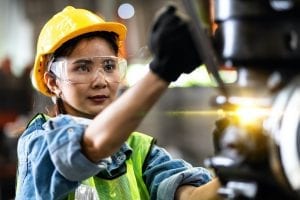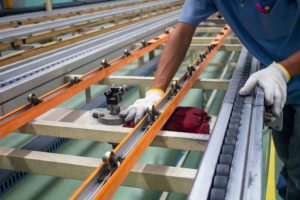3 Actions Manufacturers Can Take to Build Resilience
As manufacturing companies start to move from crisis to recovery, they need to adapt to change and adopt technology in order to be more resilient. And frontline workers in manufacturing power the heart of our supply chains. Every product that’s in high demand and is considered essential, especially during this pandemic, wouldn’t get into anyone’s hands without the massive frontline factory workforce showing up every day to do their jobs, taking risks along the way. How are we supporting these workers, given that they play such an important role during this time of crisis?
There are a number of actions companies can take to build resilience into their digital transformation efforts, as we enter the recovery and rebuild phase.
1. Adopting a Culture of Resilience
In a manufacturing context, resilience is about the ability to recover from difficulty and disruption. Given the current state of things, it’s about providing the mechanisms to bring operations back online in a viable manner, while ensuring worker safety. You should be looking to promote interactions rather than limiting them, but it’s important to do so in a safe manner.
This means being able to promote collaboration among teams and allowing workers to interact while staying safely apart and manage social distancing. As non-essential plant employees work from home, they need a way to reach the frontline, deskless workers. Teams need the ability to communicate and collaborate with one another, given that all employees are not currently working under the same roof.
Technology – specifically, connected worker technology – can help manufacturers accomplish this.
Connected worker technology connects frontline industrial workers to the people, information, systems and machines to improve safety, productivity and quality across operations.
In addition, connected worker technology captures human activity data, providing plant managers with more access to what’s happening on the plant floor. The technology can uncover roadblocks and pinpoint or reveal factors that may be causing it. Having that level of insight can help managers better adjust and control overall workflows and keep production moving at the pace it needs to, and with the quality of work it needs, to meet quota and customer expectations.
2. New Opportunities to Ramp up Operations
As you get ready to accelerate your organization to make up for lost time, the ability to cross-train your employees and adopt more flexible shift scheduling is crucial. We’re seeing activities like social distancing and shift flexibility being managed digitally.
Frontline workers need to be quickly trained on new tasks as companies are rapidly accelerating and cross-training employees to allow for a more flexible workforce, and given the increase in temporary labor. Because factories are not yet operating at full worker capacity, it’s important to make sure your workers are properly trained as they may be tasked with new or different responsibilities. Rather than having someone just focus on maintenance, line changeovers or clean/inspect/lubricate (CIL), you can embrace digital technology to get more employees trained to do multiple tasks.
Connected worker technology can help guide people to do their work effectively and accurately, which is important for so many organizations as they pivot and adopt more agile processes.
For frontline workers who may be tasked with new or different responsibilities, having digital, multimedia work instructions and real-time collaboration with offsite teams through SMS text, video, photos and more make it easier to transfer knowledge.
Many companies have been taking additional preventative maintenance steps during this period. Because of the changes in frequency in shift patterns, some manufacturers have slowed down lines from a safety perspective, so they can focus on autonomous preventive maintenance. And the pandemic has highlighted the need to increase maintenance activities during down time to improve reliability in the future, increase productivity and decrease potential exposure to COVID-19.
3. Safety is Priority #1
Safety has always been a hot topic; however it’s been accelerated during COVID-19. Frontline workers who show up day in and day out are not able to stay home and isolate themselves during this time. What is your manufacturing organization doing to protect essential workers?
There’s been a lot of discussion around how to maintain social distancing in the manufacturing environment, like marking up work areas, building social distancing into digital work instructions, and staggering shifts to minimize the number of employees on the factory floor. Several companies we’ve talked to are experimenting with Bluetooth-enabled signalling, so you can be alerted through a wearable or mobile device if someone is coming too close..
Companies can also use connected worker technology to conduct employee pre-screening. There are a number of things a worker can do before they come on site, including logging temperature checks. Employees can also fill out a survey through their mobile device and answer basic questions before they arrive at work.
If an employee tests positive, what do you do? Since you have access to all this data, you can start conducting digital contact tracing. Over the last 14 days who were you in contact with, what was the duration of that contact, where in the site did that contact occur, so if you need to do a deep clean you know where to go without shutting down the entire facility.
Beyond safety adherence itself, how can you scale safety procedures across your organization? For large enterprise companies, having new safety protocols rolled out one plant at a time, each one potentially taking months to implement, just isn’t an option during this time when every day brings uncertainty. Technology can play a key role in ensuring procedures are rolled out at scale, within a matter of days.
Digital drives accountability, which you don’t have with paper based procedures.
All this can only be achieved if we have 100% worker adoption. We can do this by enabling frontline workers with modern digital tools and making it a seamless experience for them to capture data live from the shop floor.
We are now entering a new phase of manufacturing. The global pandemic has led manufacturers to reexamine how they conduct operations. The companies that will come back more resilient are the ones that understand the importance of the role of human workers and investing in people-centered technology.







